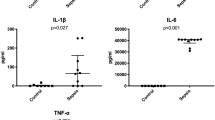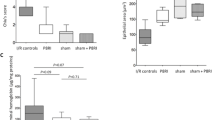Abstract
Recent evidence suggests that neutrophil recruitment may initiate cell apoptosis in ischemic tissues. We have recently shown that enterocyte apoptosis is increased following intestinal ischemia-reperfusion (IR) injury. The purpose of the present study was to examine the effect of hyperoxia on E-selectin expression, neutrophil recruitment and enterocyte apoptosis following intestinal IR in a rat. Male Sprague-Dawley rats were divided into three experimental groups: (1) sham rats underwent laparotomy without vascular occlusion and were ventilated with air (Sham) (2) IR rats underwent occlusion of both the superior mesenteric artery and portal vein for 30 min and were ventilated with air (IR), and (3) IR-O2 rats underwent IR and were ventilated with 100% started 10 min before reperfusion and continued for 6 h (IR-O2). Intestinal structural changes were determined 24 h following IR. Immunohistochemistry for E-selectin (using E-selectin cleaved concentrated polyclonal antibody) was performed to identify E-selectin immunoreactivity localized to the endothelium of venules. The recruitment of neutrophils was calculated per 100 venules. Immunohistochemistry for Caspase-3 was performed for identification of apoptotic cells. Non-parametric one-way ANOVA test was used for statistical analysis with p less than 0.05 considered statistically significant. A significant increase in E-selectin expression in the jejunum (6.1 ± 2.2 vs. 2.5 ± 1.0 E-selectin positive vessels/100 vessels, p < 0.05) and ileum (12.1 ± 2.7 vs. 3.3 ± 1.2 E-selectin positive vessels/100 vessels, p < 0.05) and a concomitant increase in neutrophil recruitment in the ileum (5.5 ± 1.6 vs. 1.3 ± 0.6 adhered PMN’s per 100 venules) were observed in IR rats compared to sham animals and were accompanied by increased cell apoptosis (p < 0.05). Treatment with 100% oxygen resulted in a significant attenuation in E-selectin expression in the ileum (2.7 ± 1.1 vs. 12.1 ± 2.7 E-selectin positive vessels/100 vessels, p < 0.05), and neutrophil recruitment in the jejunum (2.5 ± 1.4 vs. 7.7 ± 1.9 adhered PMN’s per 100 venules, p < 0.05) and ileum (1.5 ± 0.7 vs. 5.5 ± 1.6 adhered PMN’s per 100 venules, p < 0.05) compared to IR animals, and was accompanied by decreased cell apoptosis (p < 0.05). Hyperoxia inhibits enterocyte apoptosis following intestinal ischemia-reperfusion. Down-regulation of E-selectin expression with subsequent decrease in neutrophil recruitment may be responsible for this effect.



Similar content being viewed by others
References
Noda T, Ivakiri R, Fujimoto K, Matsuo S, Aw TY (1998) Programmed cell death induced by IR in rat intestinal mucosa. Am J Physiol 274:270–276
Buttke JM, Sandrtrom PA (1994) Oxidative stress as a mediator of apoptosis. Immunol Today 15:7–10
Wu B, Ootani A, Iwakiri R, Fujise T, Tsunada S, Toda S, Fujimoto K (2004) Ischemic preconditioning attenuates ischemia-reperfusion-induced mucosal apoptosis by inhibiting the mitochondria-dependent pathway in rat small intestine. Am J Physiol Gastrointest Liver Physiol 286:G580–G587
Weins SW, Lucchesi BR (1990) Free radicals and ischemic tissue injury. Trends Physiol Sci 11:161–167
Kilgore KS, Todd III RF, Lucchesi BR (1999) Reperfusion injury. In: Gallin JI, Snyderman R (eds) Inflammation: basic principles and clinical correlation. Lippincott Williams & Wilkins, Philadelphia, pp 1047–1060
Krasik EF, Yee KL, Hammer DA (2006) Adhesive Dynamics simulation of neutrophil arrest with deterministic activation. Biophys J 91:1145–1155
Eppihimer MJ, Granger DN (1997) Ischemia/reperfusion-induced leukocyte-endothelial interactions in postcapillary venules. Shock 8:16–25
Waisman D, Brod V, Wolff R, Sabo E, Chernin M, Weintraub Z, Rotshild A, Bitterman H (2003) Effects of hyperoxia on local and remote microcirculatory inflammatory response after splanchnic ischemia and reperfusion. Am J Physiol Heart Circ Physiol 285:H643–H652
Chomczynski P (1993) A reagent for the single-step simultaneous isolation of RNA, DNA and proteins from cell and tissue samples. Biotechniques 15:532–537
Patel A, Kaleya RN, Sammartano RJ (1992) Pathophysiology of mesenteric ischemia. Surg Clin North Am 72:31–41
Menger MD, Pelikan S, Steiner D, Messmer K (1992) Microvascular ischemia-reperfusion injury in striated muscle: significance of reflow paradox. Am J Physiol Heart Circ Physiol 263:H1901–H1906
Buras J (2000) Basic mechanisms of hyperbaric oxygen in the treatment of ischemia-reperfusion injury. Int Anesthesiol Clin 38:91–109
Sirsjö A, Lehr HA, Nolte D, Haapaniemi T, Lewis DH, Nylander G, Messmer K (1993) Hyperbaric oxygen treatment enhances the recovery of blood flow and functional capillary density in postischemic striated muscle. Circ Shock 40:9–13
Zamboni WA, Roth AC, Russell RC, Graham B, Suchy H, Kucan JO (1993) Morphological analysis of the microcirculation during reperfusion of ischemic skeletal muscle and the effect of hyperbaric oxygen. Plast Reconstr Surg 91:1110–1123
Tjärnström J, Wikström T, Bagge U, Risberg B, Braidem M (1999) Effects of hyperbaric oxygen treatment on neutrophil activation and pulmonary sequestration in intestinal ischemia-reperfusion in rats. Eur Surg Res 31:147–154
Kaelin CM, Im MJ, Myers RA, Manson PN, Hoopes JE (1990) The effects of hyperbaric oxygen in free flaps in rats. Arch Surg 125:607–609
Chen MF, Chen HM, Ueng SWN, Shyr MH (1998) Hyperbaric oxygen pre-treatment attenuates hepatic reperfusion injury. Liver 18:110–116
Thom S (1993) Functional inhibition of leukocyte β2 integrins by hyperbaric oxygen in carbon monoxide-mediated brain injury in rats. Toxicol Appl Pharmacol 123:248–256
Haglund U, Jodal M, Lundgren O (1984) The small bowel in arterial hypotension and shock. In: Shepherd AP, Granger DN (eds) Physiology of the Intestinal Circulation. Raven Press, New York, pp 305–319
Bitterman H, Bitterman N, Melamed Y, Cohen L (1989) Effects of hyperbaric oxygen (HBO) in circulatory shock induced by splanchnic artery occlusion and reperfusion in rats. Can J Physiol Pharmacol 67:1033–1037
Braun F, Hosseini M, Wieland E, Sattler B, Laabs S, Lorf T, Müller AR, Fändrich F, Kremer B, Ringe B (2004) Expression of E-selectin and its transcripts during intestinal ischemia-reperfusion injury in pigs. Transplant Proc 36:265–266
Xia G, Martin AE, Besner GE (2003) Heparin-binding EGF-like growth factor downregulates expression of adhesion molecules and infiltration of inflammatory cells after intestinal ischemia/reperfusion injury. J Pediatr Surg 38:434–439
Sukhotnik I, Helow H, Mogilner J, Lurie M, Bernsteyn A, Coran AG, Shiloni E (2005) Oral arginine reduces intestinal mucosal injury caused by ischemia-reperfusion in rat. Pediatr Surg Int 21:191–196
Sukhotnik I, Shehadeh N, Mogilner J, Shamir R, Helou H, Lurie M, Shiloni E (2005) Beneficial effects of oral insulin on intestinal recovery following ischemia-reperfusion Injury in rat. J Surg Res 128:108–113
Bitterman N, Bitterman H (2006) Oxygen toxicity. In: Mathieu D (ed) Handbook on hyperbaric medicine. Springer, New York, pp 731–766
Author information
Authors and Affiliations
Corresponding author
Rights and permissions
About this article
Cite this article
Sukhotnik, I., Coran, A.G., Greenblatt, R. et al. Effect of 100% oxygen on E-selectin expression, recruitment of neutrophils and enterocyte apoptosis following intestinal ischemia-reperfusion in a rat. Pediatr Surg Int 24, 29–35 (2008). https://doi.org/10.1007/s00383-007-2039-y
Published:
Issue Date:
DOI: https://doi.org/10.1007/s00383-007-2039-y




